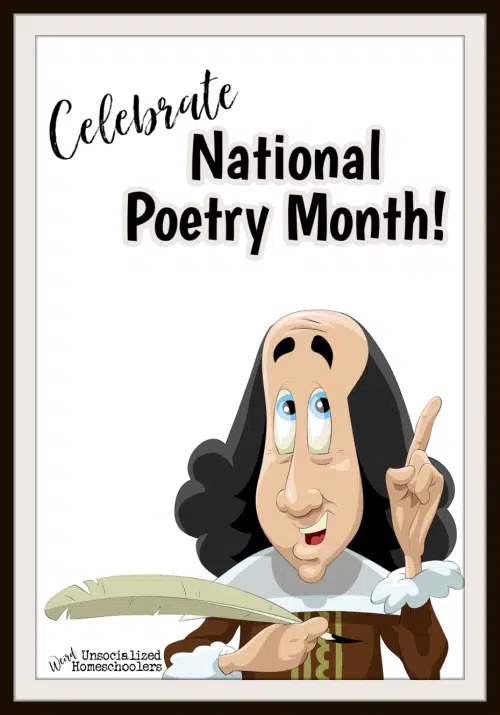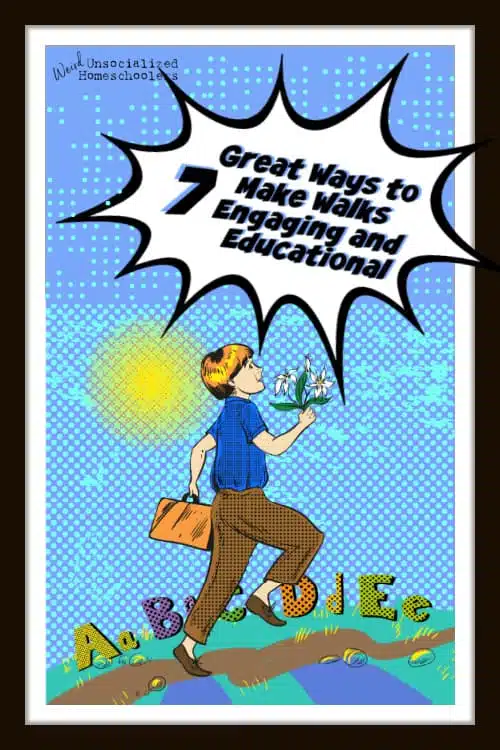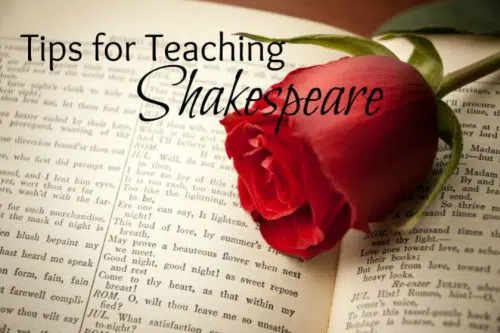Celebrate National Poetry Month! 5 No-Stress Tips for Engaging Kids and Teens in Poetry
Did you know that April is National Poetry Month? If you don’t love poetry (and even if you do), it can feel a little bit overwhelming coming up with ways to teach it to kids. Poetry can be such an important part of falling in love with language. However, it can also seem like something that’s just not as accessible to kids without teachers (AKA homeschooling parents) having to do a lot of brainwork ahead of time, right? Like how do I translate this into that? Do I need charts? How do I get my kids to understand – let alone be interested in- complicated ideas like meter and symbolism?
Do I have to figure out how do to scansion so I can teach my 10-year-old how to mark up Shakespeare’s sonnets?
Written by Kathryn of Write Where You Are.
Well, today, I’m purposefully avoiding the complex aspects of poetry. There will be no diagramming, no quizzing, and no stress, allowed. Why? Well, because there are many fundamental aspects to poetry that kids can naturally, intuitively connect with!
Starting to make those connections should be fun, not stressful. Cultivating a love of poetry simply does not have to be complex, especially at the beginning. Once your child is engaged in poetry, then you can start your formal study of Shakespeare, if you like (or, should I say As You Like It)?
But if you’re not ready for all of that yet, here are 5 totally simple, no-stress tips for getting your kids engaged in poetry. These tips are great for any and all ages (even adults).
Celebrate National Poetry Month! 5 No-Stress Tips for Engaging Kids and Teens in Poetry
1. Focus on the sound.
You know how we all have some songs that we like just because they sound cool? Well, just like with music, sound is a very important part of poetry, too! And beyond the fact that we are drawn to rhythmic words, songs (and poetry) actually help us connect with words in a deeper way, too. Melodic rhyme schemes, patterns, and cadences actually help our brains engage as they predict what is coming next!
Historical Poetry Tidbit: In fact, a lot of the oldest poetry we have today in Western civilization originates from stories that were passed on by oral tradition. The bard of a particular area would be responsible for learning all of the important stories of the region. And one of the tools they relied upon to remember all of those stories? Predictable patterns of sound!
Taking this into account, one of the easiest ways you can get kids and teens engaged in poetry is by teaching them to appreciate the presence of rhythm. You don’t have to reinvent the wheel to do it.
Talk to your kids about the fact that our brains connect differently to words when rhythm is involved. Choose some poems with clearly defined patterns of sound (most poems have a rhythm to them, but rhyming poems are going to be the easiest ones to use to demonstrate this). Read them and analyze the sound as you read, rather than the meaning of the words.
- Take turns reading the poem. Talk about which words seem to jump out and which ones seem to flow together.
- Pick out the rhyming words.
- Try coming up with ways to sing a poem like you would a song, inventing your own melody.
- Retrospectively, choose a popular song and try reading it aloud like a poem.
- See how quickly your child/teen can memorize a short poem compared to a paragraph of regular text. You may both be amazed!
When teaching poetry, many people jump right into looking at the words in poems and trying to interpret what they mean, but great poets weave meaning into the sound of poetry, too. When your kids and teens understand that basic principle, they already understand an important part of poetry that is often skipped over.
2. Try story-driven poetry.
I’ve found that a lot of kids and teens connect more readily to story-driven/narrative poetry at the beginning, probably since it’s a familiar format to them. There are plenty of excellent poems that tell a story, so why not jump in by looking at some of those, first?
For very young kids, you could even start with Mother Goose’s Nursery Rhymes (my 5-year-old is currently obsessed with these)! Shel Silverstein is always a great choice for kids of all ages.
However, there are also some great, classic narrative-driven poems for older readers, too! Do you have a teen who can appreciate some moody vibes? Try reading Edgar Allen Poe’s story-driven Gothic poem The Raven, or the melancholy Annabel Lee. Have a fantasy-loving kid or teen? Check out some of the ballad of Beowulf or the story-driven poetry of the one and only, J.R.R. Tolkien.
There’s plenty of story-oriented poetry out there to be discovered, so I know you can find just the right poem(s) to speak to your child and his or her interests!
3. Get visual (and artsy)!
We’ve talked about how sound and story can be accessible and intuitive facets of poetry for kids. However, poetry is also unique and engaging because of the way it can paint feelings and images with descriptive words.
Especially if you have a visual learner or an artsy child, I suggest reading some poems that offer a lot of imagery and vivid descriptions. Then challenge your child or teen to create a work of art that captures the images and feelings of those poems.
Here are just a few classic poems with strong images to get you started:
- Birches by Robert Frost
- I Wandered Lonely As a Cloud by William Wordsworth
- The Red Wheelbarrow by William Carols Williams
Your child can use any medium he/she wants to create a work of art that reflects the poem (s) you choose. The art could feature the word that stuck out most to him/her, it could be collage-based, three-dimensional, etc.
(If you’re not sure what medium to go with, I think collage-based art that mixes words and pictures works particularly well for this.)
If you have artistically inclined kids, another fun poetry related project to try with your kids is blackout poetry. Blackout poetry involves taking a book (or other media with words) that you don’t mind “transforming” and choosing certain words from a page of that book to create a poem. Black out the rest of the words and create art on top of the blacked out part! This is a fun and low-pressure creative challenge that kind of reminds me of working with those little refrigerator magnet words—since you have to work with what’s already there, it’s simple. It’s also really fun to see what you create! This link will take you to a full tutorial for creating blackout poetry at home.
4. Act it out.
Getting a little bit dramatic (the constructive, intentional kind of dramatic, of course!) is a great strategy to employ when engaging your kids or teens in poetry. If you’re going to be reading things out loud, you may as well rock it with flair! This is also the perfect way to make a memorization assignment extra fun.
Have your child/teen find a poem that resonates with him/her and then practice reciting and memorizing it, bit by bit. Then challenge him or her to bring some extra drama to the recitation: voice projection, props or costumes, etc.
Once the recitation is ready, there can be a performance or video recording! Let them really personalize this so that they can take ownership of it and be proud.
5. Start a creative writing journal.
Now that you’ve introduced your kids or teens to these intuitive aspects of poetry, they may feel ready to start digging a little deeper, learn more about the structures of different poems, and possibly write some poems of their own! There are many more detailed resources out there that can help young poets try different poetic forms. If your child or teen is ready, that would be a great next step to take in your study of poetry!
I would also suggest that anyone who is interested in poetry start keeping a creative writing journal!
Here are a few ideas for starting a creative writing journal.
- Collect interesting words. If a word jumps out to you because of how it sounds or what it means, write it down. Keeping up with striking words will help you as you start thinking poetically, no matter what form of poetry you want to write.
- Organize words. For an extra challenge, try keeping your collection of interesting words organized: 1 syllable words, 2 syllable words, 3 syllable words (etc.) You can also have sections for rhyming words. This will result in a great toolbox for writing poems!
- Write down your dreams each morning.
- Free write for 10-15 minutes each day, without worrying about grammar, spelling, or even making sense! Try to get it in early in the morning as a brain wake-up.
These simple, creative writing practices will help make writing poetry (or writing anything, actually) flow more naturally for kids, teens, and grown-ups too!
I hope that these super-simple, no-stress tips help make a study of poetry seem more accessible and fun. Poetry can be complicated…but engaging your kids in poetry doesn’t have to be! A lot of the things that we love about poetry have to do with its innate accessibility. I hope these tips help you tap into that. Let me know if plan on trying any of them! Happy Poetry Month!
You May Also Like:
How to Make Your Kids Want to Write (or at Least Grumble a Little Less)
7 Great Ways to Make Walks Engaging and Educational
Poetry Study on The Crocodile by Lewis Carroll
3 Simple Tips for Teaching Shakespeare
Katie Gustafson has been a member of the world of “weird, unsocialized homeschoolers” for a long time–first as an alumnus and now as a homeschooling mom to a fiercely fun little girl! She’s very into anything creative, especially writing, dancing, and painting. She’s also particularly passionate about literature and owns more books than she will probably ever be able to read. However, she reassures herself with the belief that, in the event of a digital apocalypse, she’s cultivating a much-needed physical library for future generations. Katie is happy to contribute articles to Weird Unsocialized Homeschoolers, Hip Homeschool Moms and Sparketh. She also has a personal blog on writewhereuare.com.













Thank you for Sharing